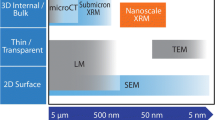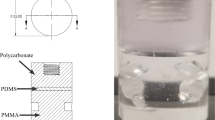Abstract
The double-torsion (DT) test is commonly used to calculate slow or subcritical crack velocities in (quasi-)brittle engineering materials directly from the measured load relaxation of notched DT-specimens. In cementitious materials a significant part of the recorded load relaxation in the DT-test may be due to specimen creep deformation, and this would then lead to overestimated crack velocities. In this paper we describe a method to optically measure slow crack growth in cementitious materials by carrying out DT-tests under the optical microscope or inside the environmental SEM. Crack tip detection is facilitated by digital image correlation of the time-lapse microscope recordings. DT-tests at 10 % relative humidity in hardened cement paste (with w/c-ratio of 0.4, 0.5 and 0.6) showed that optically measured crack velocities were significantly lower than those calculated from the DT-specimen relaxation. In many experiments the subcritical crack growth rapidly stopped, while an ongoing specimen load relaxation was recorded. At 90 % relative humidity, load-relaxation in the DT-test was much stronger than at 10 % relative humidity, because subcritical cracking and creep-induced relaxation both increase with moisture content.








Similar content being viewed by others
References
Mindess S (1985) Rate of loading effects on the fracture of cementitious materials. In: Shah SP (ed) Application of fracture mechanics to cementitious composites. Martinus Nijhoff, The Netherlands, pp 617–638
Wittmann FH (1985) Influence of time on crack formation and failure of concrete. In: Shah SP (ed) Application of fracture mechanics to cementitious composites. Martinus Nijhoff, The Netherlands, pp 593–616
Bažant ZP, Gettu R (1992) Rate effects of and load relaxation in static fracture of concrete. ACI Mat J 89:456–468
Bažant ZP, Xiang Y (1997) Crack growth and lifetime of concrete under long time loading. J Eng Mech 123:350–358
Van Zijl GPAG, De Borst R, Rots JG (2001) The role of crack rate dependence in the long-term behaviour of cementitious materials. Int J Solids Struct 38:5063–5079
Bažant ZP, Gu WH, Faber KT (1995) Softening reversal and other effect of a change in loading rate on fracture of concrete. ACI Mater J 92:3–9
Wiederhorn SM, Freiman SW, Fuller ER, Simmons CJ (1982) Effects of water and other dielectrics on crack growth. J Mater Sci 17:3460–3478
Freiman SW (1984) Effect of chemical environments on slow crack-growth in glasses and ceramics. J Geophys Res 89(NB6):4072–4076
Atkinson BK (1984) Subcritical crack growth in geological materials. J Geophys Res 89(B6):4077–4114
Stöckl S (1967) Tastversuche über den Einfluss von vorangegangen Dauerlasten auf die Kurzzeitfestigkeit des Betons, Deutscher Ausschuss für Stahlbeton No. 196:1–27
Shah SP, Chandra S (1970) Fracture of concrete subjected to cyclic and sustained loading. J Am Concr I 67:816–825
Hughes BP, Ash JE (1970) Some factors influencing the long-term strength of concrete. Mater Struct 3:81–84
Coutinho AS (1977) A contribution to the mechanism of concrete creep. Mater Struct 1:3–16
Nadeau JS, Mindess S, Hay JM (1974) Slow crack growth in cement paste. J Am Ceram Soc 57:51–54
Mindess S, Nadeau JS, Hay JM (1974) Effect of different curing conditions on slow crack growth in cement paste. Cem Concr Res 4:953–965
Evans AG, Clifton JR, Anderson E (1976) The fracture mechanics of mortars. Cem Concr Res 6:535–548
Beaudoin JJ (1985) Effect of humidity on subcritical crack growth in cement paste. Cem Concr Res 15:871–878
Beaudoin JJ (1985) Effect of water and other dielectrics on subcritical crack growth in Portland cement paste. Cem Concr Res 15:988–994
Denarié E, Cécot C, Huet C (2006) Characterization of creep and crack growth interactions in the fracture behaviour of concrete. Cem Concr Res 36:571–575
Wecharatana M, Shah SP (1980) Double torsion tests for studying slow crack-growth of Portland cement mortar. Cem Concr Res 10:833–844
Husak AD, Krokosky EM (1971) Static fatigue of hydrated cement concrete. J Am Concr I 68:263–271
Barrick JE, Krokosky EM (1976) The effects of temperature and relative humidity on static strength of hydrated Portland cement. J Test Eval 4:61–73
Beaudoin JJ (1982) Effect of humidity and porosity on fracture of hardened Portland cement. Cem Concr Res 12:705–716
Rossi P, Boulay C (1990) Influence of free water in concrete on the cracking process. Mag Concr Res 42:143–146
Bažant ZP, Prat PC (1999) Effect of temperature and humidity on fracture energy of concrete. ACI Mater J 85:262–271
Wittmann FH (1970) Einfluss des Feuchtigkeitsgehaltes auf das Kriechen des Zemensteins. Rhelo Acta 9:282–287
Bažant ZP, Asghari AA, Schmidt J (1976) Experimental study of creep of hardened Portland cement paste at variable water content. Mater Struct 9:279–290
Neville AM, Dilger WH, Brooks JJ (1983) Creep of plain and structural concrete. Construction Press, London, New York, p 361
Mindess S, Diamond S (1980) A preliminary SEM study of crack propagation in mortar. Cem Concr Res 10:509–519
Mindess S, Diamond S (1982) A device for direct observation of cracking of cement paste or mortar under compressive loading within a scanning electron microscope. Cem Concr Res 12:569–576
Diamond S, Mindess S, Lovell J (1983) Use of a Robinson backscatter detector and “wet cell” for examination of wet cement paste and mortar specimens under load. Cem Concr Res 13:107–113
Diamond S, Bentur A (1985) On the cracking in concrete and fiber-reinforced cements. In: Shah SP (ed) Application of fracture mechanics to cementitious composites. Martinus Nijhoff, The Netherlands, pp 87–140
Tait RB, Garrett GG (1986) In situ double torsion fracture studies of cement mortar and cement paste inside a scanning electron microscope. Cem Concr Res 16:143–155
Williams DP, Evans AG (1973) A simple method for studying slow crack growth. J Test Eval 1:264–270
Bažant ZP, Raftshol WJ (1982) Effect of cracking in drying and shrinkage specimens. Cem Concr Res 12:209–226
Bisschop J, Wittel F (2010) Contraction gradient induced microcracking in hardened cement paste. Cem Concr Comp. doi:10.1016/j.cemconcomp.2011.02.004
Fuller ER (1979) An evaluation of double-torsion testing-analysis. Fract Mech Appl Brittle Mater: 3–18
Choi S, Shah SP (1997) Measurement of deformations on concrete subjected to compression using image correlation. Exp Mech 37:307–313
Hild F, Roux S (2006) Digital image correlation: from displacement measurement to identification of elastic properties: a review. Strain 42:69–80
Bažant ZP, Bai SP, Gettu R (1993) Fracture of rock: effect of loading rate. Eng Fract Mech 45:393–398
Atkinson BK, Meredith PG (1987) The theory of subcritical crack growth with applications to minerals and rocks. In: Atkinson BK (ed) Fracture mechanics of rock. Academic Press, London
Røyne A, Bisschop J, Dysthe DK (2011) Experimental investigation of surface energy and subcritical crack growth in calcite. J Geoph Res B-Solid Earth. doi:10.1029/2010JB008033
Shyam A, Lara-Curzio A (2006) The double-torsion testing technique for determination of fracture toughness and slow crack growth behavior of materials: a review. J Mater Sci 41:4093–4104
Evans AG, Wiederhorn SM (1984) Proof testing of ceramic materials: an analytical basis for failure prediction. Int J Fract 26:355–368
Evans AG (1973) A simple method for evaluating slow crack growth in brittle materials. Int J Fract 9:267–275
Acknowledgments
We thank Mariano Pauli, Ernst Bleiker, Heinz Richner, Gabriele Peschke, Carsten Rieger, Dominik Meyer, Robert Flatt for their assistance in this project. This project was financed by the Swiss National Science Foundation (SNF), project nr. 200021-119787.
Author information
Authors and Affiliations
Corresponding author
Rights and permissions
About this article
Cite this article
Cai, W., Bisschop, J. Optical method for measuring slow crack growth in cementitious materials. Mater Struct 45, 1613–1623 (2012). https://doi.org/10.1617/s11527-012-9860-z
Received:
Accepted:
Published:
Issue Date:
DOI: https://doi.org/10.1617/s11527-012-9860-z




